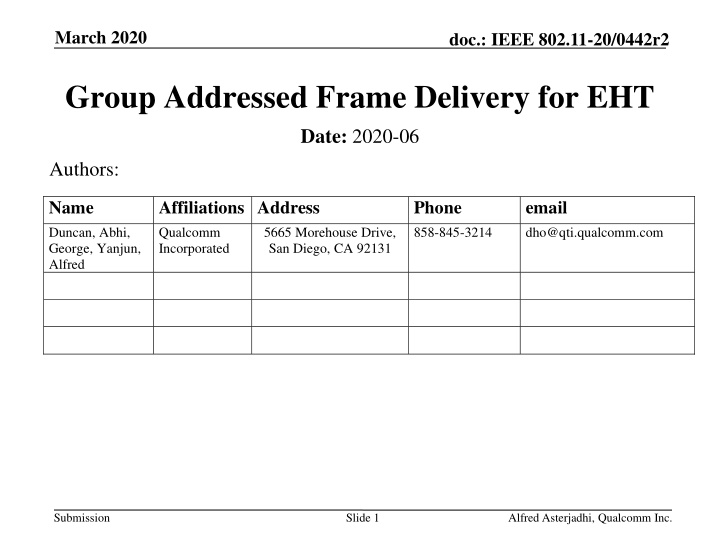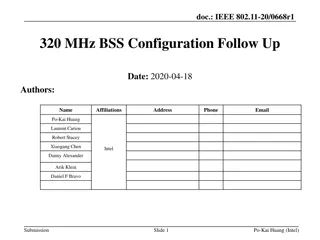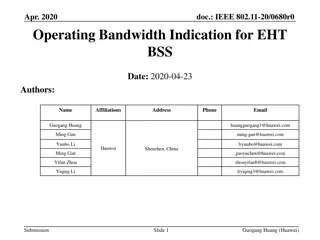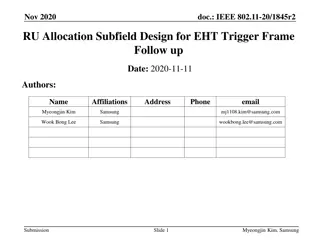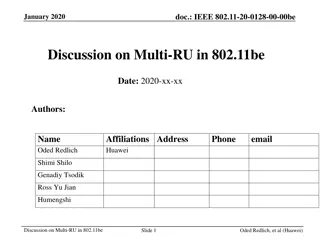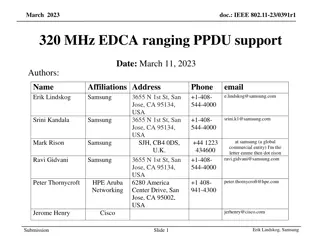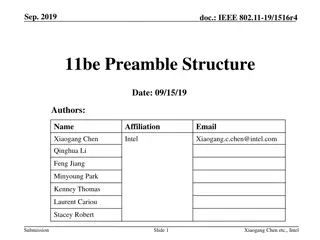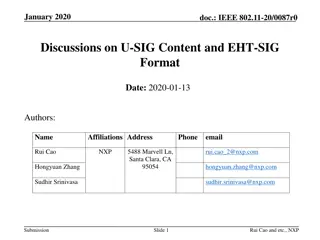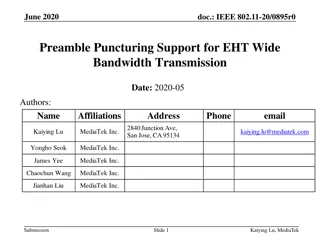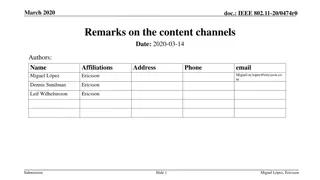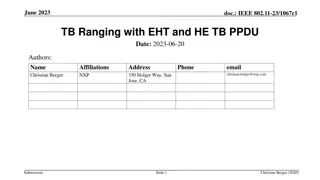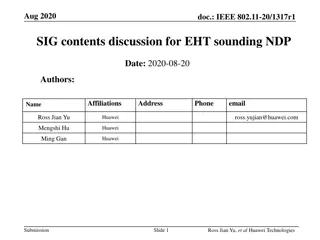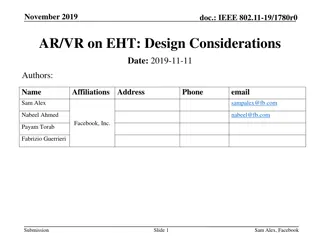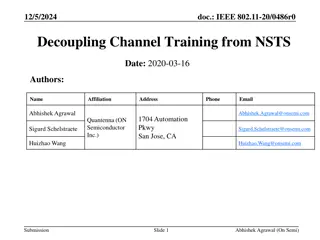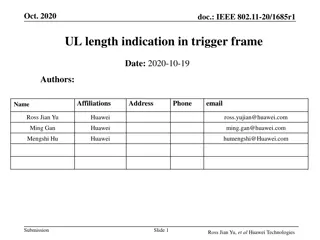Group Addressed Frame Delivery for EHT in IEEE 802.11-20
Proposed clarifications for group addressed frame delivery in a multi-link context in IEEE 802.11-20, considering different capabilities of STAs and APs. Covers modes of operation, beacon generation, and delivery mechanisms for group frames.
Download Presentation

Please find below an Image/Link to download the presentation.
The content on the website is provided AS IS for your information and personal use only. It may not be sold, licensed, or shared on other websites without obtaining consent from the author.If you encounter any issues during the download, it is possible that the publisher has removed the file from their server.
You are allowed to download the files provided on this website for personal or commercial use, subject to the condition that they are used lawfully. All files are the property of their respective owners.
The content on the website is provided AS IS for your information and personal use only. It may not be sold, licensed, or shared on other websites without obtaining consent from the author.
E N D
Presentation Transcript
March 2020 doc.: IEEE 802.11-20/0442r2 Group Addressed Frame Delivery for EHT Date: 2020-06 Authors: Name Affiliations Address Phone email Duncan, Abhi, George, Yanjun, Alfred Qualcomm Incorporated 5665 Morehouse Drive, San Diego, CA 92131 858-845-3214 dho@qti.qualcomm.com Submission Slide 1 Alfred Asterjadhi, Qualcomm Inc.
March 2020 doc.: IEEE 802.11-20/0442r2 Introduction Currently, STAs associated with an AP receive frames that are: Individually addressed to that STA (TA = AP, and RA = STA) Group addressed to multiple STAs (TA = AP, and RA = group address) Group addressed DL BU delivery follows baseline DTIM/FMS mechanisms Note that broadcast frames fall into this category as well Delivery of group addressed frames becomes less clear due to The presence of multiple links within the BSS and The existence of multiple MAC addresses at the AP side We propose to clarify group delivery in a multi-link context Considering the different capabilities the STAs might have Preserving legacy operation, and covering different use cases of interest Submission Slide 2 Alfred Asterjadhi, Qualcomm Inc.
March 2020 doc.: IEEE 802.11-20/0442r2 Considerations The proposal covers different operation modes With the AP having different MAC addresses for each link (as per SFD) Generate Beacons in all of the active links (mode 1) First Mode: Multi-Link Group Addressed BU delivery Generate Beacons in one (subset) of the active links (mode 2) Second Mode: Single Link Group Addressed BU delivery With the STA having the following operating modes/capabilities: Single-Radio STA (i.e., STA can move from one link to another but cannot operate on more than one link at the same time) Multi-Radio STA (i.e., STA can operate in multiple links at the same time) Non-STR STA (i.e., cannot receive and transmit simultaneously) Submission Slide 3 Alfred Asterjadhi, Qualcomm Inc.
March 2020 doc.: IEEE 802.11-20/0442r2 Mode 1: Multi Link (ML) Group delivery An AP MLD schedules group delivery in every link Each AP generates own Beacons and schedules group DL BU delivery in its link Broadcast/group frames of the link are scheduled in this link as per baseline (DTIM etc.) An AP duplicates group addressed Data frames of other links in this link if: A member non-AP MLD belonging to the group is expected to only be awake in this link Note: This leads to duplicated group addressed DL BU delivery over multiple links Duplicate group addressed Data frames in other links satisfy the following TA is that of the AP transmitting the frames (of this link) and RA is the MAC address of the group Encryption uses the GTK of the AP transmitting the frames (not of other AP) (independent PNs as well) Sequence Number of the duplicated Data frames can be: Independent sequence Number w.r.t. original Data frame (enables duplicate avoidance) Preferred option as it preserves link independence (already separate GTKs, and PNs) Same sequence number as original Data frame (enables duplicate detection) Submission Slide 4 Alfred Asterjadhi, Qualcomm Inc.
March 2020 doc.: IEEE 802.11-20/0442r2 Mode 1: ML Group delivery (cont.) A non-AP STA wakes in any link to receive group addressed BUs Baseline protocols are used (e.g., DTIM/FMS) for wake/doze state transitions E.g., STA wakes to read DTIM beacon, and if group addressed DL BUs are present then Remain awake until RX of group addressed frame with MD=0 or until DTIM interval is over If non-AP STA is a Single Radio STA then STA needs to ensure not switch links during this period (possibility of frame losses) Link switching may lead to either frame losses or to duplicate receptions If non-AP STA is a Multi Radio STA then STA shall discard group addressed BUs RXed during this period in any link but one Submission Slide 5 Alfred Asterjadhi, Qualcomm Inc.
March 2020 doc.: IEEE 802.11-20/0442r2 ML Group delivery-Summary Pros: STAs can wake on any link to receive group addressed frames Provides legacy support in all links maintained by the MLD AP Improves reception reliability of group addressed frames to EHT MLD STAs MR STAs can receive group addressed frames in all links and discard duplicates This is possible only if Duplicate Detection is advertised Cons: Requires replication of group addressed frames over multiple links Increased per-BSS airtime due to multiple beacons and group addressed frames This type of traffic is generally sent at lowest MCS/BWs etc., to increase likelihood of reception Not friendly to low latency and time sensitive traffic Submission Slide 6 Alfred Asterjadhi, Qualcomm Inc.
March 2020 doc.: IEEE 802.11-20/0442r2 Mode 2: Single Link (SL) Group delivery An AP MLD schedules group delivery only on one* link One AP* generates Beacons and schedules group delivery in this link No Beacons are generated in remaining links (including group BUs) May provide cross-link DTIM on other links (e.g., TIM broadcast, etc.) Can account for configuration requests from MLD STAs to elect the link Baseline protocols (e.g., DTIM/FMS) schedule group delivery in the link AP does not schedule delivery of individually addressed frames for an SR STA in other link(s) during group addressed DL BU delivery No particular considerations for individual frames for a MR STA unless MR STA is a non-STR STA in which case the AP should not cause the STA to transmit frames if the other STA of the MLD is receiving group addressed frames from the other AP of the MLD *Here focusing on one link but AP MLD can elect more than one link of the set (e.g., use two links in this mode and keep one link free of Beacons etc.) Slide 7 Submission Alfred Asterjadhi, Qualcomm Inc.
March 2020 doc.: IEEE 802.11-20/0442r2 Mode 2: Single Link (SL) Group delivery Non-AP STA wakes to receive group addressed frames in one link Baseline protocols (e.g., DTIM/FMS) used for wake/doze state transitions E.g., STA reads DTIM beacon, and if group DL BUs are present then Stay awake until RX of group addressed frame with MD=0/until DTIM interval is over SR STA is assumed to be in doze state in other link(s) during this period And is expected to not be switching channel during this period MR STA can be in any state in other link(s) during this period Can receive individually addressed frames in other links while receiving other frames (including group addressed) in this link AP is expected to satisfy any non-STR limitation that the MR STA might have Submission Slide 8 Alfred Asterjadhi, Qualcomm Inc.
March 2020 doc.: IEEE 802.11-20/0442r2 Single Link Group Addressed BU delivery Pros: Simple extension of baseline rules for group addressed delivery No need to duplicate group addressed frames on other links No per-BSS airtime increase (single beacons and group addressed transmissions) Low latency and time sensitive friendly since other links are free from this type of traffic Cons: Requires STAs to be awake in the anchor link during group addressed delivery No legacy support in links other than the anchor link Submission Slide 9 Alfred Asterjadhi, Qualcomm Inc.
March 2020 doc.: IEEE 802.11-20/0442r2 Summary We discuss two operation modes for group delivery in MLO BSS Mode 1: Multi-Link Group Addressed Delivery AP replicates group traffic over multiple links STA discards duplicated frames based on defined duplicate avoidance rules Mode 2: Single Link Group Addressed Delivery AP sends group traffic only on one link (or subset thereof) STA receives group traffic only on one link (or subset thereof) We additionally propose that Mode 1 is added in Rel-1 (beneficial for legacy support) Mode 2 is added in Rel-2 (beneficial for low latency/time sensitive traffic) Submission Slide 10 Alfred Asterjadhi, Qualcomm Inc.
March 2020 doc.: IEEE 802.11-20/0442r2 Straw Poll 1 Do you agree to add to the TGbe SFD the following For R1, each AP affiliated with an STR AP MLD shall follow the baseline rules for scheduling Beacon frame transmissions Submission Slide 11 Alfred Asterjadhi, Qualcomm Inc.
March 2020 doc.: IEEE 802.11-20/0442r2 Straw Poll 2 Do you agree to add to the TGbe SFD the following A non-AP MLD shall follow the baseline rules to receive the group addressed data frames on one link selected by the non-AP MLD The non-AP MLD may change the selected link at any time except during an ongoing group addressed delivery period The non-AP MLD shall discard any group addressed data frames that are not received in the selected link Submission Slide 12 Alfred Asterjadhi, Qualcomm Inc.
March 2020 doc.: IEEE 802.11-20/0442r2 Straw Poll 3 Do you agree to add to the TGbe SFD the following An AP MLD shall schedule group addressed DL BU delivery in all the links at which its affiliated APs generate Beacon frames Group addressed DL BU delivery from each affiliated AP follow baseline group addressed delivery rules for that link (e.g., DTIM, FMS, etc) Group addressed DL BUs of another link shall be duplicated and scheduled for transmission in this link if at least one member non-AP MLD belonging to that group is expected to be receiving group addressed frames Submission Slide 13 Alfred Asterjadhi, Qualcomm Inc.
March 2020 doc.: IEEE 802.11-20/0442r2 Straw Poll 4 Do you agree to add to the SFD: An AP MLD shall not cause a non-AP STA affiliated to a non- STR MLD STA to transmit an MPDU in a constrained link if another non-AP STA affiliated to the same STR MLD STA is scheduled to be receiving group addressed DL BUs in another link Submission Slide 14 Alfred Asterjadhi, Qualcomm Inc.
